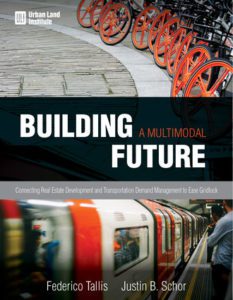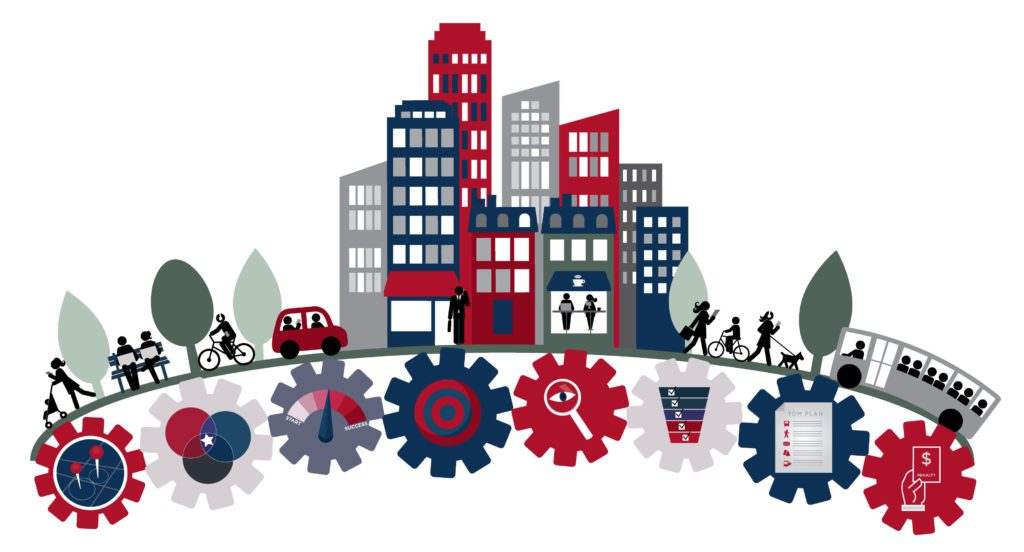By Justin B. Schor and Brian J. Horan
Single-occupancy vehicles (SOV) are great, until they aren’t. That often means gridlock – when that nice car you drive starts to seem more like a prison than a luxury. As transportation and parking consultants who work with developers, commuters, residents, architects, and others in Colorado and across the country, we are constantly helping people manage this complex issue.
Regions such as Denver are increasingly grappling with traffic and parking. For commuters, gridlock is a pain. For developers, building parking spaces is expensive. And in the real world, those parking infrastructure costs are simply passed on to residents and commuters.
There are no simple “I win, they lose” options.
Does your property need a TDM Plan in the City of Denver? Learn more about how we build, implement, and manage TDM Plans for developers on our Denver TDM Plans page.
One Gridlock Solution: Transportation Demand Management
What are the solutions? A technical term called “Transportation Demand Management” (TDM) is a key one. In layperson’s terminology, it means: incentivize and help residents and commuters to use non-SOV commuting methods, including carpools, mass transit, biking, off-peak driving, and telecommuting.

For regions that have become accustomed to single-occupancy driving, that may sound like a fantasy. But TDM is a real thing, and in many places it is being actively deployed by developers, property managers, employers, and elected officials. The City of Denver will soon require TDM plans for many properties and developers.
One region that has been dealing with these challenges for a while is the Virginia suburbs of Washington, D.C. “Northern Virginia” consists of a number of counties and independent cities, with Fairfax County being the most populous and, perhaps, vehicle-challenged of them all. This is also a region where our transportation consulting firm, Wells + Associates, has cut its teeth on this issue.
For better or worse, our nonstop focus on designing and implementing TDM systems qualifies us as being transportation nerds that love helping developers promote other ways to move around other than driving.
Denver’s Goals: Reduce Solo Car Trips, Improve Regional Transportation
Clearly, things can’t go on the way they are here in Denver. As Denverite points out, by 2030 Denver “thinks it can take the 68 percent of solo car commutes down to 50 percent while raising the other modes from a combined 15 percent (approximately) to 30 percent.”
Denver “thinks it can take the 68 percent of solo car commutes down to 50 percent while raising the other modes from a combined 15 percent (approximately) to 30 percent.”
So how does that happen?
In the simplest of terms, TDM can either be required (regulated) or voluntary. When counties and municipalities begin requiring developers to have TDM plans, these developers and property owners need to show that they are trying to reduce car trips. We have a lot of experience in this field, both in Northern Virginia and elsewhere.
Over the last 10 years we have helped dozens of properties implement these types of TDM requirements, but we made sure they were delivered as integrated transportation amenities at their new developments. A variety of different developments that have integrated TDM programs into their properties include:
- A Transit-Oriented Regional Shopping Mall (Access Tysons)
- A Live-Work-Play Mixed-Use Development (Mosaic)
- A one-million-square-foot office park (Towers Crescent)
- A Transit-Oriented Development (Modera Avenir Place)
One might ask, why would a developer embrace TDM solutions? Developers agree to TDM requirements because it allows them to increase their density, and in some cases reduce their parking requirements and costs, so this becomes a win-win for developers, residents, and the community. In many of these cases, we have represented the developer perspective in creating and refining TDM requirements.
![]()
Tom Kiler, managing director at EDENS, the developer of Northern Virginia’s popular Mosaic mixed-use development, said, “We initiated our TDM program to be a leader in Fairfax County and help us connect more effectively to the Dunn Loring metro station and make Merrifield a more walkable community. We made sure it was woven into the fabric of how we market and promote the Mosaic District. Doing so attracted value-driven customers looking for a walkable and transit-oriented community to live, work and play. The results were that the percentage of our residents not driving increase from 32% to 41% in 4 years.”
Developers agree to TDM requirements because it allows them to increase their density, and in some cases reduce their parking requirements and costs, so this becomes a win-win for developers, residents, and the community.
There are further benefits. TDM solutions help developers sell their properties and lease them up faster. Furthermore, their tenants also express how much they appreciate these transportation amenities that come with TDM solutions. So TDM becomes a tenant retention tool, too.
But do TDM requirements need to be, well, required? Our experience has shown that, while regulated TDM is a fact of life and necessary to help alleviate traffic in many communities like Denver, voluntary TDM activity is increasing. The transportation amenities that TDM brings have become so appreciated that properties without TDM requirements are voluntarily creating amenities. For example, you can read about the Silverline Center in Tysons, Virginia, a redeveloped office building, to see how they integrated TDM solutions and transportation amenities into their revamped property.
The transportation amenities that TDM brings have become so appreciated that properties without TDM requirements are voluntarily creating amenities.
Integrating TDM Programs Into Land Use Planning Across the United States
Although Fairfax County is a great example of a jurisdiction that has seen success with its TDM requirements for developers, many other jurisdictions across the United States have had success with TDM programs.

Urban Land Institute’s newly published book, Building a Multimodal Future: Connecting Real Estate Development and Transportation Demand Management to Ease Gridlock, provides many real-world examples of urban, suburban, and small-town communities that have implemented TDM policies in unique contexts. The book was co-written by my colleague Justin Schor, who has participated with us on Colorado-area transportation projects.
Justin recently was the keynote speaker at the Greater Valley Forge Transportation Management Association’s (GVF) annual awards breakfast to talk about the book, where he stated that TDM shouldn’t be used as a mere band aid for traffic congestion problems. Rather, he said that “a far more effective method of addressing congestion issues is integrating TDM into land use policies, before issues with congestion arise.”
ULI’s Building a Multimodal Future has a practical side to it. For example, it lists nine steps to guide readers through the process of establishing TDM policies in their own projects and communities. These include:
- Understand How the TDM Policy Fits into the Planning Fabric of the Community
- Identify Where the TDM Policy Should Apply
- Determine the Types of Developments That Should Comply with the TDM Policy
- Select an Appropriate Metric to Quantify Site-Based Success
- Set the Appropriate Goal to Quantify Site-Based Success
- Establish How the TDM Policy Will Be Monitored
- Determine Appropriate TDM Strategies for Properties Affected by the TDM Policy
- Determine Whether a TDM Plan Is Required
- Decide on an Enforcement Mechanism to Ensure TDM Policy Compliance
Denver appears to be following these nine steps on its journey to develop a well thought-out TDM policy for new development.

Potential Next Steps for Denver
So what options does the greater Denver area have? Denver is mulling over a plan to introduce Transportation Demand Management requirements into its planning. There are opportunities for Denver to experience similar benefits as other regions have, should the draft plan be approved in 2020. The details are unclear, but Denverite reports that “as of right now new buildings would have to build some type of sustainable transport infrastructure, onsite or off.”
However the details of the plan end up, there are opportunities for developers of new properties and companies at existing properties to create and implement TDM plans that give commuters, tenants, and communities opportunities for transportation choices beyond the single-occupancy car ride.

